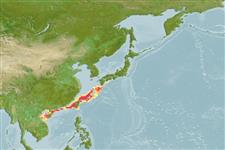Environment: milieu / climate zone / depth range / distribution range
Ecología
marino. Temperate
Distribución
Países | Áreas FAO | Ecosistemas | Ocurrencias, apariciones | Point map | Introducciones | Faunafri
Northwest Pacific: Taiwan.
Tamaño / Peso / Age
Maturity: Lm ? range ? - ? cm
Max length : 4.3 cm TL macho / no sexado; (Ref. 31443)
Short description
Claves de identificación | Morfología | Morfometría
Body in formalin yellowish throughout the body with black dots on the back; fins hyaline. Deciduous thin scales.
Life cycle and mating behavior
Maturities | Reproducción | Spawnings | Egg(s) | Fecundities | Larva
Shen, S.C., 1960. Bregmaceros lanceolatus and Bregmaceros pescadorus, two new species of dwarf fishes from southern Taiwan and Pescadore Islands. Q. J. Taiwan Mus. 13 (1-2):67-74. (Ref. 31443)
IUCN Red List Status (Ref. 130435)
Threat to humans
Harmless
Human uses
Herramientas
Special reports
Download XML
Fuentes de Internet
Estimates based on models
Preferred temperature (Ref.
123201): 16.5 - 23.5, mean 20.7 °C (based on 69 cells).
Phylogenetic diversity index (Ref.
82804): PD
50 = 0.5001 [Uniqueness, from 0.5 = low to 2.0 = high].
Bayesian length-weight: a=0.00372 (0.00152 - 0.00908), b=3.19 (2.97 - 3.41), in cm total length, based on LWR estimates for this (Sub)family-body shape (Ref.
93245).
Nivel trófico (Ref.
69278): 3.1 ±0.3 se; based on size and trophs of closest relatives
Fishing Vulnerability (Ref.
59153): Low vulnerability (10 of 100).
